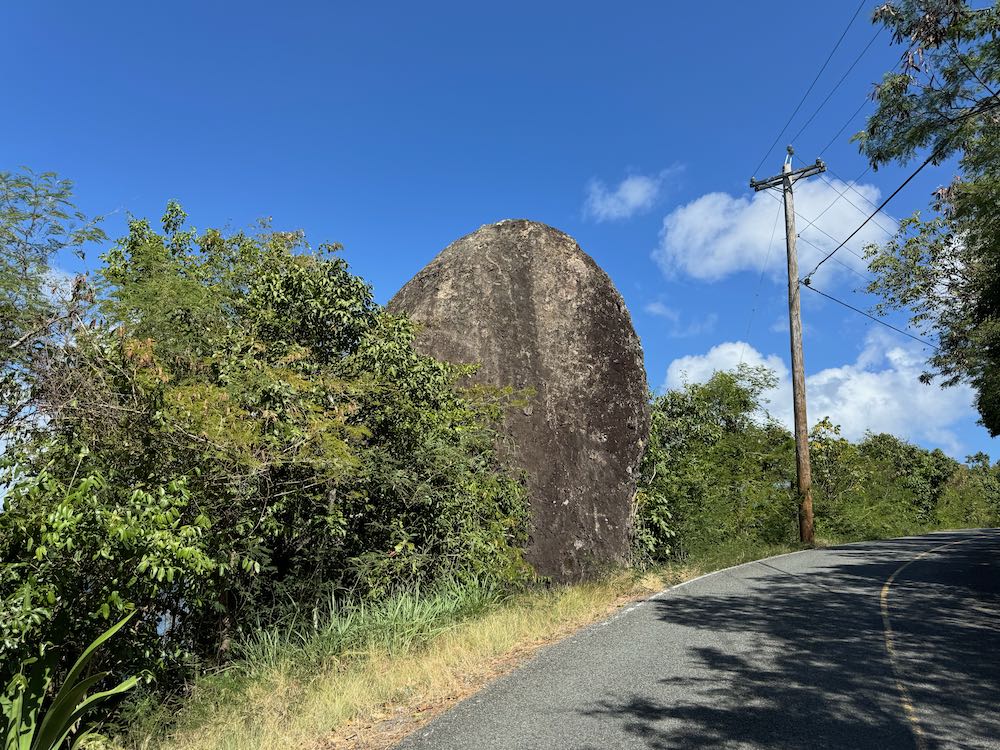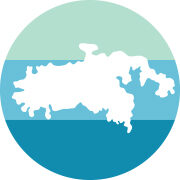
It’s a story I have told more than a thousand times… the legend of Easter Rock. 🙂
How many of you have driven past Hawksnest Bay and noticed the large rock on the left just before the Peace Hill parking lot? That’s Easter Rock, and according to the legend, it will roll down to Hawksnest Bay Sunday morning.
Easter Rock is a large boulder that’s perched on the side of North Shore Road above Hawksnest Bay. Legend has it that every year on the night before Easter, Easter Rock makes its way down to Hawksnest Bay where it takes a drink of water and then rolls back up to its perch on North Shore Road. This all happens before the sun rises over the hill, according to the legend, so no one is around to actually witness it. So even during the driest of droughts, Easter Rock will still be wet on Easter morning.
(Side note: We could totally use some rain!)
I’m not able to check it out for myself this weekend, but if any of you are, I’d love to see some pics!
Legend aside, here is the geological backstory straight of Easter Rock. The following is courtesy of SeeStJohn.com:
Although geologists have not yet succeeded in explaining Easter Rock’s propensity to go down to the sea on Easter Sunday for a drink of water, they can tell us about the origin of this massive boulder, which is the only one of its kind in the valley.
The outer crust of the Earth consists of large masses of slowly moving rock called tectonic plates. About 100 million years ago, one of these plates, called the North American plate, which was moving towards the west, encountered another tectonic plate called the Caribbean plate, which was moving in the same direction.
Life in the Caribbean has long been classified as slower moving than in the fast-paced world of continental America. This phenomenon apparently has a historical and geological foundation because a significant factor in the creation of many of the Caribbean islands, including St. John, is the fact that the Caribbean plate happened to be moving at a slower pace than its continental counterpart.
Consequently, when the North American plate overtook the slower moving Caribbean plate, the American plate, being denser and heavier, slid under the Caribbean plate and pushed it up. The friction from the two giant masses of solid rock grinding against one another produced a heat so intense that it melted some of the rock between the two plates. The fiery, liquefied rock, called magma, built up in enclosed pockets, called magma chambers, and exerted an ever-increasing pressure on the surrounding rock. When that pressure became so great that it could not be contained any longer, the magma broke through its rocky chamber and spewed forth violently into the ocean. This event is called a volcano.
Normally, when super-hot magma comes in contact with cold ocean water, the magma explodes and is dispersed over a great area. In this case, however, the eruption occurred at a depth of 15,000 feet, or nearly three miles, below the surface of the ocean. At this great depth the water pressure is nearly 7,000 pounds per square inch, a pressure that was sufficient to keep the magma from exploding on contact with water and instead causing it to be deposited on the ocean floor in giant solid sheets.
Coinciding with this volcanic activity and the laying down of rock, the action of the American plate sliding under the Caribbean plate caused the latter to bulge at the edges. The combination of these events resulted in the beginnings of a mountain range that was to become the islands of the Greater Antilles. This process of volcanic activity and uplifting continued for millions of years and caused the newly formed mountains to move closer to the surface.
It was during the next period of St. John’s development that Easter Rock was born. A series of volcanoes erupted in the area of what is today called Pillsbury Sound. This time the water was relatively shallow and the volcanoes erupted explosively. The shower of rocks, solidified volcanic ash, and molten lava added substance and height to the older solid sheets of rock and, in conjunction with the continued uplifting of the area, eventually brought parts of the rocky underwater mass above sea level to form islands.
The awesome power of these violent eruptions also served to break off huge chunks of the older rock, heaving them into the air. One of these massive fragments ended up just above what was to become Hawksnest Bay. That majestic boulder, now known as Easter Rock, not only goes down to the sea every Easter for a drink of water, but also serves as an enduring reminder of the fiery beginnings of the island of St. John.
And there you have it!
I plan to take a few days off for the Easter holiday while Dalton enjoys his spring break. Have a fantastic week and Happy Easter everyone!
Take a St. John island tour with me!
Get to know St. John. Visit beautiful beaches & centuries-old plantations. Perhaps stop at a tiki bar or two. Full & half days available. Rated “Excellent” on TripAdvisor. 2023 & 2022 TripAdvisor Travelers’ Choice Winner. Learn more here –> www.explorestj.com/tour
Follow Explore STJ on Social Media
–> www.facebook.com/explorestj
–> www.instagram.com/explorestj

Easter Rock is yet another wonderful part of St. John that we have loved for SO many visiting years—too bad that it’s water break has never been recorded—nor the tracks of it! LOL! Keep on enjoying your drink, E-Rock! Hope to see you again, soon…